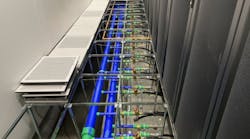iMasons Climate Accord Unites Major Hyperscalers for Better Reporting on Data Centers' Carbon Impact
The iMasons Climate Accord (ICA) and major hyperscalers are calling for better reporting on the carbon impact of data centers, and challenging mission-critical vendors to provide enough data to support standardized reporting.
The Governing Body of the ICA, a program of Infrastructure Masons representing a coalition unified behind carbon reduction in digital infrastructure, is calling on all suppliers serving data centers to support greater transparency in Scope 3 emissions as part of broader efforts to reduce the industry’s carbon footprint.
Consisting of Google, Microsoft, Amazon Web Services (AWS), Meta, Digital Realty and Schneider Electric, the Governing Body released an open letter on July 16 that explains the importance of "widespread adoption of Environmental Product Declarations (EPDs), which are standardized, third-party-verified documents reporting the embodied emissions of a product."
As noted by iMason Climate Accord, EPDs outline the greenhouse gas emissions of a product through its entire lifecycle, from the raw materials in the product (e.g., how they are extracted, transported, and processed), to manufacturing, transportation, product use, and product end-of-life (e.g., landfill, recycling, repurposing, etc.).
“EPDs are crucial in transforming the future of digital infrastructure to be more resilient and climate positive,” said Miranda G. Gardiner, LEED Fellow, Executive Director of iMasons Climate Accord. “As standardized and verified data provides a layer of transparency, this initiative supports a collective approach to reducing our carbon emissions and environmental footprints.”
The new joint effort spearheaded by iMasons is designed to align vendors with the largest customers and their goals, in the hope that market forces can drive standardized reporting and disclosure, which would benefit everyone in the digital infrastructure ecosystem.
“To enable the digital infrastructure industry to align with net-zero emissions goals, carbon emissions must be a fundamental consideration in procurement decisions,” observed iMasons Governing Body Member Anna Timme, who is also the Head of Sustainability for Secure Power and Data Centers at Schneider Electric. “Promoting industry-wide adoption of EPDs is a critical step in enabling carbon-informed decision making. Schneider Electric has been dedicated to publishing EPDs since 2008, and we are excited about the significant impact that industry adoption will have as we collectively progress toward net-zero.”
More EPDs Needed for Data Center Decarbonization
Notwithstanding, despite the forthright stance of companies such as Schneider Electric, while an increasing number of local, state, and federal procurement policies request EPDs across multiple industries, there is not widespread adoption of EPDs in the data center industry.
In response to this challenge, the aforementioned open letter hosted by the iMasons Climate Accord demonstrates a significant catalyst from the world’s largest hyperscalers and digital infrastructure companies to drive meaningful change across the industry, working in partnership with their trusted suppliers.
The letter focuses on accelerating reductions in data center embodied carbon emissions. It states:
The emissions footprint of digital infrastructure can be viewed in two large groupings: Operational emissions, like those that come from powering data centers, and embodied emissions, capturing the emissions contribution from manufacturing, transporting, and constructing the infrastructure themselves...To lower data center embodied emissions, a company must first estimate those emissions, establish a baseline, and then leverage this information as a key criterion in procuring data center materials and equipment. Embodied emissions can be estimated using common lifecycle analysis software...
The Greenhouse Gas Emissions (GHG) footprint of a product or material can then be captured in an Environmental Product Declaration (EPD) – a standardized, third-party verified document that reports the embodied emissions of the product. One can view the EPD as a 'nutrition' label of a material. EPDs are then used to estimate the embodied carbon footprint of a project, in this case a data center, based on the actual volume of material or counts of products purchased.
The open letter goes on to note how a challenge facing the data center industry - and other industries - is that there are simply not enough vendors producing EPDs and making them available for data center owners and operators.
iMasons and its partners contend this shortage of EPDs hampers the industry’s ability to procure lower-carbon materials and equipment, as well as to reflect vendor emissions reductions in the industry's reporting to key stakeholders - including regulators - which can jeopardize contracts with some customer groups.
EPDs Bring Scope 3 Into Focus
iMasons Climate Accord notes that hyperscalers have previously implemented strategies to reduce and/or mitigate Scope 1 and 2 emissions. In their quest for net-zero carbon emissions in coming years, the next piece of the sustainability puzzle for these companies lies in reducing Scope 3 emissions, which can represent anywhere from 38-69% of data centers’ total carbon footprint. Scope 3 emissions are not produced by the company itself; rather, they include the indirect emissions throughout the value chain.
“As leaders in the digital infrastructure sector, we recognize the urgent need to address all facets of our carbon footprint, particularly Scope 3 emissions which constitute a significant portion of our environmental impact,” said Lex Coors, Chief Data Center Technology & Engineering Officer for Digital Realty, and Infrastructure Masons Governing Body member.
Coors added, “By advocating for the adoption of EPDs, we are not just committing to transparency; we are taking a decisive step towards empowering the entire industry to make informed, responsible choices that align with our collective sustainability ambitions. This initiative is crucial as we strive to meet the growing demands of our digital world in a sustainable and accountable manner.”
ICA emphasizes that access to the critical information in EPDs empowers data center owners, operators, and end-users to effectively calculate their environmental impact and choose products (servers, cooling systems, uninterruptible power supplies) and services based on lower Scope 3 emissions, for optimal alignment with sustainability targets.
“In line with our commitment to open standards and our company-wide goal to achieve net-zero emissions across all our operations and value chain, we support industry-wide adoption of Environmental Product Declarations as a crucial lever in low-carbon procurement of digital infrastructure,” affirmed Joe Kava, Vice President, Global Data Centers, Google. “As a member of the Governing Board of iMasons Climate Accord, Google is excited to help accelerate solutions that drive progress toward a more sustainable, transparent data center industry.”
A Net Zero Milestone
With the 250+-member iMasons Climate Accord representing an $8 trillion combined market cap, the organization feels that widespread adoption of EPDs is likely to have a profound impact on reducing global data center carbon emissions.
"These declarations will play an important role in accelerating decarbonization efforts for the data centers of tomorrow,” said Rachel Peterson, VP, Infrastructure Data Centers at Meta. “Reducing our emissions is Meta’s top priority to reach net zero emissions across our value chain in 2030. We join our peers in calling for greater transparency in the data center supply chain to better understand the embodied carbon of the infrastructure that underpins our operations."
Recognizing that it is essential to continue to ensure the digital infrastructure industry decarbonizes as it grows, it perhaps goes without saying how the signatories of the iMasons Governing Body’s open letter all have net-zero carbon emissions commitments in place to address their responsibility in mitigating data center carbon emissions, with deadlines ranging from 2025 to 2040 - about ten years ahead of the Paris Agreement, notes ICA.
“At AWS, we are committed to reaching net-zero carbon emissions across our operations by 2040 by investing in carbon-free energy, scaling solutions, and collaborating with partners to broaden our impact,” said Eric Wilcox, Vice President of Data Center Engineering at AWS. “We support the iMasons call for all suppliers to adopt the use of Environmental Product Declarations (EPDs) to accelerate these efforts. By doing so it will provide greater transparency in Scope 3 emissions embodied in equipment and help accelerate the overall industry’s efforts to reduce its carbon footprint.”
The new open letter is the second issued by the ICA calling for action from suppliers to accelerate decarbonization efforts. In April 2023, the Governing Body of the ICA called on data center industry suppliers to use lower-carbon concrete in data center infrastructure.
About the Author
Matt Vincent
A B2B technology journalist and editor with more than two decades of experience, Matt Vincent is Editor in Chief of Data Center Frontier.



